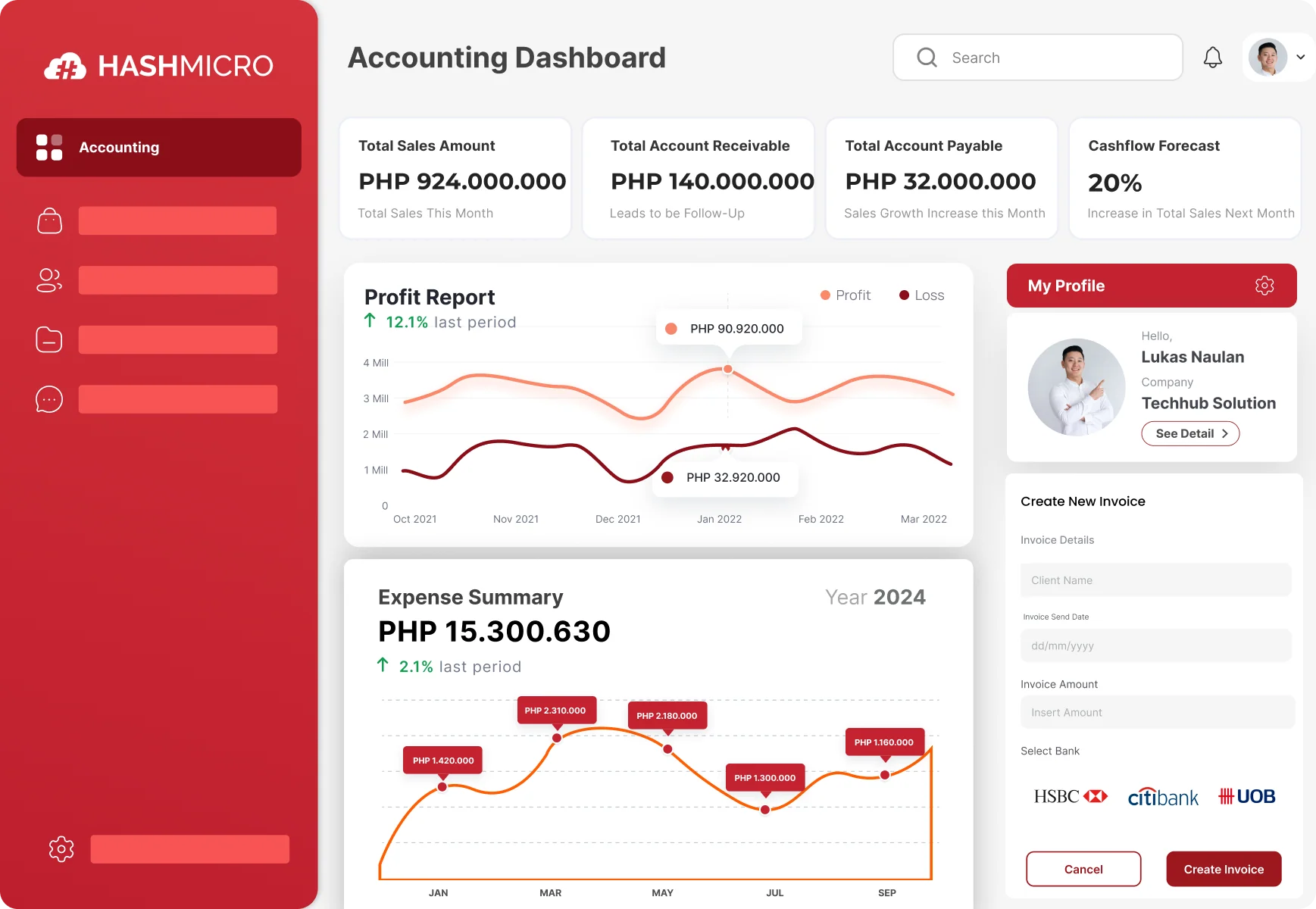Operating income is the profit a company generates after subtracting operating expenses from net sales revenue. It reflects the core profitability of a business, excluding non-operating costs like taxes and interest.
Calculating and managing operating income can be complex, especially when factoring in various expenses and ensuring accurate data. Accounting software can streamline this process, automating calculations and improving accuracy.
Ang pag-unawa sa kita sa pagpapatakbo ay mahalaga para sa tagumpay sa pananalapi. Keep reading to discover how managing this key metric can unlock better financial health and decision-making for your company.
Table of Contents

Key Takeaways
|
What is Operating Income?
Operating income is the profit remaining after subtracting the costs of day-to-day operations from net sales revenue. It includes both direct expenses, such as the cost of goods sold (COGS), and indirect expenses like administrative and marketing costs.
It excludes non-operating expenses like taxes, interest, and one-time charges, ensuring a clear view of the company’s core performance.
Operational profit is a key measure of a company’s ability to generate profit from its core business activities. It highlights the efficiency of operations while excluding factors that could skew profitability.
It is used to calculate the operating profit margin, a percentage that shows how much profit is generated from each dollar of sales. This helps compare companies within the same industry and track trends over time.
What is Net Operating Income?
Net Operating Income (NOI) is the income generated from a property or business after deducting all expenses, but before taxes and financing costs. It typically applies to real estate and investment analysis.
NOI is calculated by subtracting operating expenses such as maintenance, management fees, and utilities from the total revenue generated by the property or business.
It is a key metric for investors and businesses, helping assess the profitability of an asset or operation and its potential for generating cash flow.
Why is Operating Income Important?
Operating income is a crucial metric that shows a company’s core profitability by measuring how well it generates revenue while managing operational costs. It highlights financial stability and growth potential. Here’s why it’s so important for businesses and investors.
- Profitability from core operations: It demonstrates a company’s ability to generate profit after covering operational expenses, showing core business performance.
- Funds for growth or rewards: Profits from operating margin can be reinvested to fund growth or distributed to owners and investors, supporting long-term sustainability.
- Indication of long-term success: Consistent core profit suggests a company can thrive without outside funding, indicating financial stability and resilience.
- Growth and cost control: An increasing business profit over time shows that a company is growing revenue while controlling operating costs, reflecting operational efficiency.
Components of Operating Income
Operating income is calculated by subtracting two main types of expenses from net sales: direct costs (COGS) and indirect costs (SG&A).
Direct costs (COGS) are expenses directly tied to the production of goods or services. These include:
- Materials and supplies that are used in manufacturing products.
- Wages for employees working directly on production.
- Utilities consumed by manufacturing facilities.
- Depreciation of production assets like equipment and machinery.
Subtracting these direct costs from net sales gives the gross income.
On the other hand, indirect costs (SG&A) refer to expenses that are not directly related to production but are necessary for running the business. These include:
- Salaries for management and administrative staff.
- Office supplies and other operational costs.
- Marketing and advertising expenses.
- Sales costs, including travel and commissions.
- Depreciation of non-production assets like computers and office equipment.
Subtracting these indirect costs from gross profit gives the final operating return, reflecting the company’s ability to generate profit from its core operations.
Operating Income Formula
There are several ways to calculate operating surplus, each using different approaches depending on available data. Below are the three approaches for calculating the operating income formula.
1. Top-down approach
In this method, operating income is calculated by subtracting operating expenses, depreciation, and amortization from gross profit. The formula is:
Operating Income = Gross Profit – Operating Expenses – Depreciation – Amortization
Gross profit is derived from net revenue minus COGS, and operating expenses exclude interest and taxes.
2. Bottom-up approach
The bottom-up approach starts with net income and adds back interest expense and tax expense, as these are subtracted when calculating net income. The formula is:
Operating Income = Net Income + Interest Expense + Tax Expense
This method requires a complete income statement, as net income is the final figure listed.
3. Cost accounting approach
The cost accounting approach calculates operating income by subtracting direct and indirect costs from net revenue. The formula is:
Operating Income = Net Revenue – Direct Costs (COGS) – Indirect Costs (SG&A)
Companies often use this method internally, classifying costs for internal reporting purposes and excluding interest and taxes.
Operating Income vs Net Income
Operating income reflects the profit after deducting COGS and operating expenses from net sales, focusing solely on core business operations. In contrast, net income includes all revenues and expenses, such as taxes, interest, and non-operating items like investments or asset sales.
Net income, often referred to as the “bottom line,” represents the final figure reported on an income statement. It provides a complete picture of a company’s profitability after accounting for all costs, including non-operating and one-time expenses.
On the income statement, operating income usually appears above net income and will typically be higher, as net income includes additional deductions like interest and taxes. Operating profit serves as a key indicator of core operational performance.
Operating Income vs EBIT and EBITDA
EBITDA add back interest, taxes, depreciation, and amortization to net income, offering a broader view of profitability. Unlike operating surplus, EBITDA includes non-operating income and excludes depreciation and amortization.
On the other hand, EBIT and operating income are very similar, both measuring profit from core operations. The key difference is that EBIT may include additional non-operating expenses, but for most companies, they are essentially the same.
Operating Income Examples
To illustrate how you calculate business profit, consider the following operating income example. Imagine Pilipinas Furniture Co., a fictional mid-sized manufacturing company based in Manila that specializes in creating custom furniture for both residential and commercial spaces.
The company has built a strong reputation for quality craftsmanship and has expanded its customer base across various regions in the Philippines. It is currently focusing on optimizing its operations to increase profitability.
| Description | Amount (PHP) |
| Net Sales | 25,000,000 |
| Direct Costs (COGS) | 12,500,000 |
| Gross Income (Net Sales – COGS) | 12,500,000 |
| Indirect Operating Expenses (SG&A) | 5,000,000 |
| Operating Income (Gross Income – SG&A) | 7,500,000 |
Explanation:
- Net sales: Pilipinas Furniture Co. generated ₱25,000,000 in net sales from its furniture business.
- Direct costs (COGS): The company deducted ₱12,500,000 in direct costs (COGS), which include materials and labor for production.
- Gross income: After subtracting COGS from net sales, the company achieved a ₱12,500,000 gross income.
- Indirect operating expenses (SG&A): The company incurred ₱5,000,000 in indirect operating expenses (SG&A), such as administrative salaries and marketing costs.
- Operating income: The resulting operating margin of ₱7,500,000 reflects the company’s profitability from its core operations.
Understanding how to calculate core earnings is crucial for assessing your company’s profitability and financial health. To get a better idea of how you can optimize your financial operations, download our detailed pricing scheme and explore the best solutions for your business today!

Calculate Operating Income With HashMicro Accounting Software
As highlighted earlier, accurately calculating and managing operating income is crucial for maintaining financial stability and making informed business decisions. To support this, HashMicro offers an accounting software solution designed to streamline financial processes and ensure precise calculation of operational profit.
HashMicro Accounting Software is the Philippines’ leading solution for businesses seeking to optimize their financial operations. Trusted by over 2,000 enterprises across Southeast Asia, it provides a comprehensive system that supports efficient financial management and accurate reporting.
Key features of HashMicro Accounting Software that help manage operating return include:
- Integrated with Hashy AI for Finance: HashMicro e-Invoicing Software integrates with Hashy AI, utilizing a chat-based interface to handle payables and collections, automate invoicing, payment tracking, and vendor communication.
- Bank integrations: Seamless synchronization of transactions with multiple bank accounts for easy reconciliation and accurate financial data.
- Multi-level analytical: Generate detailed financial reports segmented by project, branch, or department for precise comparisons and analysis.
- Automated currency update: Automatic updating of exchange rates for accurate foreign transactions and multi-currency management.
- Manual and automated double-bookkeeping: Both manual and automated double-entry bookkeeping methods record all financial transactions in two accounts.
- In-depth accounting reports: Provides comprehensive reports like financial ratios, partner aging, bank and cash book, tax reports, AR collection, and journal reports for detailed financial insights.
- Equity movement report: Tracks changes in equity, including capital contributions and retained earnings, for clear ownership and financial growth records.
Conclusion
To conclude, operating income is the profit a company earns after deducting operating expenses from net sales revenue, focusing on core business profitability. It is a vital metric for assessing financial health and operational efficiency.
HashMicro Accounting Software simplifies the calculation of operating income by automating the process and providing accurate financial insights. It ensures you can track and manage your operating revenue with ease.
Dalhin ang iyong pamamahala sa pananalapi sa susunod na antas gamit ang HashMicro. Try our free demo today. Experience firsthand how our software can help you optimize profitability and streamline accounting processes!

Frequently Asked Questions About Operating Income
-
What’s the difference between operating income and profit?
Operating income, also known as operating profit, is the amount that remains after subtracting business expenses from gross profit. It reflects the profitability of a company’s core business activities.
-
What is considered a good operating income?
A 10% operating profit margin typically indicates average performance, while a 20% margin signals excellent performance. It’s also crucial to monitor the company’s debt interest payments as part of the overall assessment.
-
What does positive operating income mean?
Positive business profit shows that a company is generating profit from its primary operations, which is vital for long-term sustainability. It also provides investors and stakeholders with a clear view of the company’s financial health and efficiency.








































